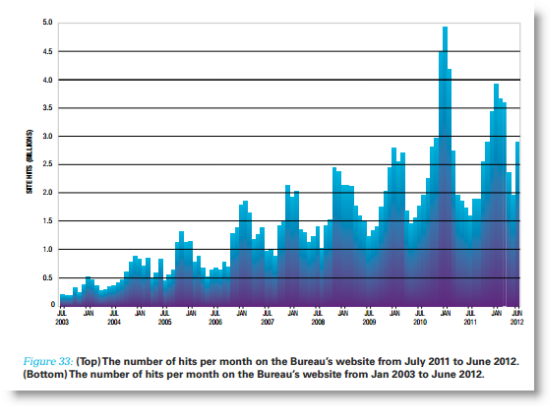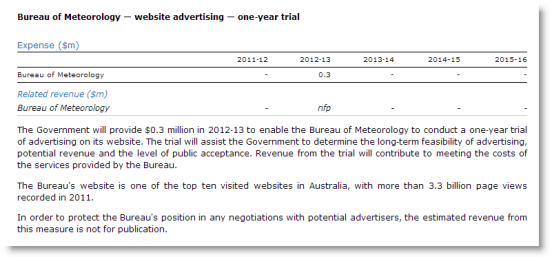Paid advertising has appeared on a federal government website for the first time, a move advertising baron Harold Mitchell estimates will net the Bureau of Meteorology $2 million a year.
The ads for NAB ran for a limited time yesterday. More will follow.
Weather nerds are up in arms over the commercialisation of their-much loved site, but Mitchell says ads will help reduce the cost of a public service in a difficult economic climate. Medicare is another target, and Mitchell would go as far as the ABC.
“They should have done it years ago,” Mitchell told Crikey. “It’s the perfect way to monetise a service paid for by the people … This is perfectly acceptable and wise and responsible. I’ve always said the ABC, their digital services, that would be another major revenue stream [for advertising].”

The government announced in the 2012-13 budget ads would be trialled on BOM for one year. Private firm Digital Network Sales is managing the process.
BOM has been picked because it’s the government’s most visited website, and it has massive traffic spikes during natural disasters and severe weather. The government won’t say how much the trial might earn and says all the cash will go back to BOM. According to the Bureau, the website received 3.3 billion page views in 2011, and 64 million users visited the site in 2011-12.
Mitchell — a prominent ad space buyer and key shareholder in industry giant Aegis Media — is impressed. “That’s nearly everybody,” he said, calculating the ads would net $2 million a year.
Denis Muller, media ethicist at the University of Melbourne’s Centre for Advancing Journalism, doesn’t share Mitchell’s unbridled enthusiasm. “Presumably it’s going to open up possibilities for other government agencies to also accept paid advertising,” he said.
Muller raises concerns about editorial independence; that the BOM ads could influence the type of weather and climate information run on the site. For example, if a concreting company were to sponsor the site, it could end up devoting more resources to running information about expected rainfall. Would BOM run ads for commercial sites like The Weather Channel and Weatherzone? Similarly, Muller suggests Medicare might one day run ads because of its high online traffic — and asks whether private health insurers will be allowed to sponsor it.
“What about the space on the website, what are they taking off, will it be harder for people to find [weather information]?” Muller asked. “Who gets the money?”
BOM says there will be no ads on pages dedicated solely to weather warnings. Pop-ups and in-page videos are banned. The ads will run on the right side of the webpage, above the fold. Rotating blocs of ads are allowed, but BOM has scotched ads for gambling, lotteries, alcohol, any ads aimed at children or “of a political nature”. The government censors will ensure there is no “advertising containing s-xually explicit content and/or s-xual innuendo”, which would have been quite eye-opening on the staid weather site.
Muller isn’t necessarily opposed to the presence of advertising if it brings a public benefit in the form of revenue (BOM’s annual budget is $324 million), but says there should be a strong on-site disclaimer that the ads are paid for and don’t represent endorsement by the Bureau.
BOM chief operating officer Vicki Middleton said in a statement the ad trial is “a potential revenue stream to assist the Bureau in meeting increasing demand for essential frontline services and flood forecasting systems”:
“Many commercial entities and media organisations use Bureau data in the delivery of weather information, and generate revenue from these activities. It makes sense for the scientific body responsible for this data to benefit directly. While the Bureau is the first Australian Government agency to carry commercial advertising on its website, meteorological service providers in other countries, including the UK Met Office, already carry commercial advertising on their website.”
Mitchell rebutted Muller’s concerns, saying ads could be carefully regulated and consumers understand the difference between information and advertising. The BBC carries advertising (for overseas online viewers only) and the Australia Network (run by ABC International) runs ads overseas. SBS, which receives public funding, has ads on its website and TV channels. Mitchell points out Crikey runs advertising while maintaining its editorial kudos.
Mitchell says digital advertising has soared from a very small base and is likely to be the biggest ad medium in 2014, overtaking newspapers and television. “Why would anybody turn their back on that?” he said.

Graph from BOM’s annual report showing growth in traffic (measured in billions of hits per month), with spikes in summer









Perhaps if it generated $2 Billion in income, I might be more enthusiastic about jumping on to the slippery slope.
But for a pathetic $2 mill??? No thanks.
As for Harold Mitchell…..
Since Crikey’s a nice, family friendly website, I’ll spare you the enraged electrons.
I have no problems with the BOM taking advertising for things like banking etc.
Maybe not so sanguine if Lord Monckton was advertising .
Different case for the ABC, on line or on air. It is nice to have a news outlet that has no commercial considerations when it comes to news/opinion reporting.
Look at Ch 9. Possibly compromised becasue of the Waterhouse/Singo controversy. Then theres’ Andrew Johns. A commentator and obvioulsy a punter with Tom W. What if a commentator gets badly indebted to the bookie? It could affect his commentary and it could show up in the banter with other commentators
Initially paid advertising seems innocent enough but there a number of negative externalities that will inevitably creep in – as they always do once the Trojan horse has passed the gates.
A few:
1 Real information gets crowded out by ads
2 the old/ young/ low iq get confused and think the ads are government products or are government endorsed.
3 advertisers pressure the sites to remove / delete data they dislike or add data they like under threat of removal of advertising/ sponsorship. As happens to traditional media.
4 next step could be the total outsourcing of the whole site / privatisation of the service with all those problems (short term profit focus and lack of maintenance and investment) and a focus on income generation not providing infomation which is surely the main aim of government sites.
5 bandwidth clogged up with video, audio, pop ups etc when simple text information that’s mobile friendly is all that’s required.
Etc
Next thing you know Gillard will be doing 2 minute ads in parliament before question time as we need the income to pay for Parliament House!
A terrible decision that will serve to fragment the advertising dollar even more and weight it away from journalism platforms.
The BOM is a monopoly information provider, resourced by public funds, and therefore able to unfairly compete against anyone seeking to provide a competitive advertising platform.
I think that there is something in the ‘slippery slope’ argument. The BOM should have no agenda other than to gather, analyse and present weather- and climate- related data, science and forecasts. There are two problems I see:
– the BOM would come under increasing pressure to find its own funding, with public funding being being constricted and possibly wound back.
– advertisers will want to influence what is presented or emphasised and what is not presented or buried. This could be explicit (think the Coal Industry and Climate Change) or more subtle (with the BOM directing its efforts to the more lucrative areas).